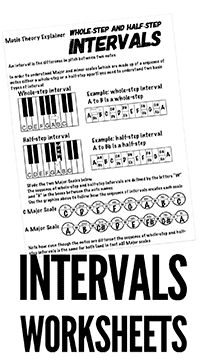
What you get in our $18.00
"one click" 400+ PDF Music Theory Worksheets download.....
Download ALL of our resources to your phone, tablet and/or PC for just $18.00
$18.00
The following material is an in depth look at the resources. It should be stressed that from here the materials are divided into topic areas (scales, chords, theory etc) and the sequence of subject areas on this part of the page are not the order in which the worksheets and handouts should be presented to students
A comprehensive list of the
Music Theory Worksheets
in our "one click" download

Music Theory Handouts: 13 Sheets
Thirteen handouts (as opposed to worksheets) covering some key concepts of music theory. Areas covered include Major Scales, Minor Scales, Blues Scales, Major and Minor Pentatonic Scales and the four main types of triad (Major Minor Augmented and Diminished) as well as the four diatonic 7th chords (maj7, m7, 7 and m7(b5) chords
The handouts seve equally well as wall charts covering key concepts and topics for your music classroom wall

Music Theory Explained: 7 Sheets
Designed to complement the 13 music theory handouts shown above the "one click download" also contains a range of more detailed music theory "explainers" which are effective for both classroom use and as part of distance learning or online learning packs that can be used as circumstances dictate
Use in the classroom or for distance learning/revision
Some of the explainers (such as the one to the left of the graphic above) can currently be dowloaded free from this site while the two to the right of the image looking at topics such as the diatonic system or pentatonic scales feature as part of the paid for download
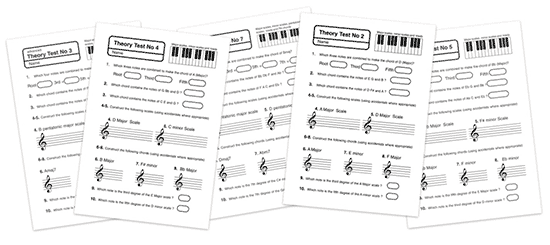
Music Theory Test Papers
There are twenty music theory test papers in the download
Ten basic one sheet theory tests and ten more advanced ones. Each test comes in two versions One version uses notated forms and the other requires that students enter only the letter name in order to answer each question. This allows an educator to work using the same material with a group of students with differing entry behaviours and prior experience before embarking on a course of study.
A typical classroom music group is made up of students who have prior experience of notated forms (those who have a background in "formal" music education) working alongside students who arrived there with a background in popular music (Rock, R'n'B, Jazz, Country etc) where the emphasis on musical notation is greatly reduced (if it exists at all)

Music Theory Tests:Answer sheets
The twenty theory tests also come complete with (letter name only) answer sheets so that students can mark their own work or find out where they went wrong on any given test
The tests can be used as a diagnostic tool (to find out accurately student's level of understanding with relation to notes, scales, chords and keys) as well as a reliable way to track progress throughout a term or semester
Scales and Intervals
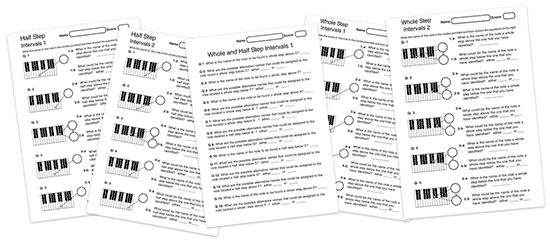
Whole and Half Step Intervals: 5 Sheets
In order to construct Major and minor scales our students only need to initially develop an understanding of whole-step and half-step intervals. There are five sheets designed to introduce the concept of these intervals and then to reinforce understanding of those concepts
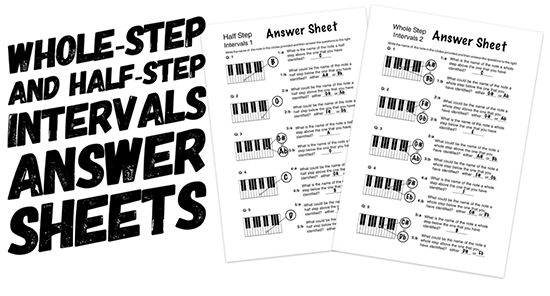
Whole and Half-Step Intervals Answer Sheets
Answer sheets for the above early stages worksheets (where students are required to provide the letter names of notes a whole-step or a half step from specified starting notes) are included in the download. They can be uploaded to smartboards etc for classroom sessions or used for self-study They can also be used as part of distance learning packs to be uploaded to school technology systems etc
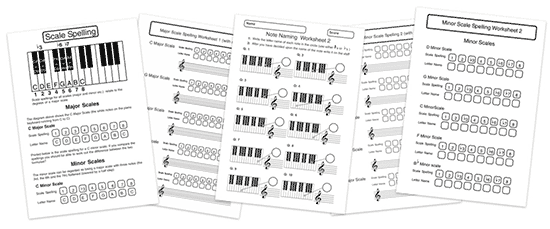
Note Naming and Scale Spelling: 36 Sheets
There are a whole range of sheets here that look at the principles which underpin the correct naming of notes here that do not rely upon notation. This material also includes worksheets with varying levels of graphic support (keyboard diagrams and scale formulae etc). When students understand the principles involved then worksheets designed to be used later in a programme of study featuring notation and a musical staff may be introduced
The 36 sheets that make up this part of the download are designed to allow a teacher to cover the same ground with a group of students who have differing levels of prior knowledge, attainment and capability. Some sheets have no need of notation and feature a whole load of "prompts" (in the form of keyboard diagrams, scale formulae etc) whereas others require students to use their own learning to this point and go straight to using notated music.
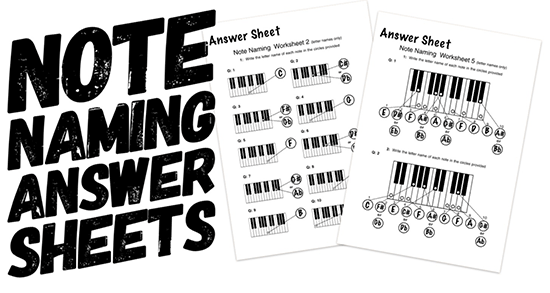
Note Naming "Letter Name Only" Answer Sheets
Again answer sheets are included in the download for the worksheets where students are required to supply the letter names specified on the worksheets

Major Scale Note Naming Only: 4 Sheets
How to correctly identify the names of the notes in any Major Key using the "correct" starting note and sequence of whole-step and half-step intervals. These resources are among the most well used and valued materials in the download. If you enlarge the graphic above you will see the small circle (between each of the large circles) contains a "W" (for a whole-step) or an "H" (indicating a half-step interval). Used alongside the keyboard graphic at the top of each sheet these resources are a great way to help ensure that ALL of your students understand the Major Scale
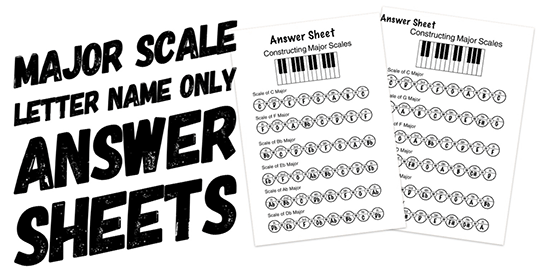
Major Scale Construction: Letter Name Only Answer Sheets
The four Major Scale Worksheets that require students to supply the correct letter name for each degree of the scale are also accompanied by answer sheets that you can choose to use (or not?) in the delivery of your music theory teaching

Mixed Scale Spelling Worksheets: 4 Sheets
When students are secure with the way that Major Scales are constructed from pre determined sequence of whole and half-step intervals then it is time to bring the same principles to bear with a look at the sequences of intervals that make up other common scale types. A great way to keep more theoretically advanced students gainfully occupied while you spend time explaining first principles to the relative novices in your class group

Major Scales with Key Signatures: 8 Sheets
Materials designed to help class members to fully understand how keys work and that all keys essentially follow the same "rules" rather than just to be able to recite the number of sharps or flats in each key

Key Signature Worksheets: 4 Sheets
This material provides an opportunity to develop and reinforce a familiarity with keys and key signatures. If you look at the worksheets above you will see that two of them have a visual "prompt" in the form of a keyboard graphic while the remaining pair oblige a student to complete the worksheets using only the theories and concepts that they have internalised
Download all of the resources now for only $18.00
A lifetime supply of resources to use "year on year" for less than the cost of a single text book!
$18.00

Mixed Scale Worksheets Musical Staff Only: 5 Sheets
Material for more advanced students who are already (or who have become as a result of your wonderful teaching!) familiar with musical notation or who are ready to start working with it. There are no graphic "prompts" (keyboard diagrams, scale formulae etc) on these worksheets and there are a whole range of scales (Major pentatonic, minor pentatonic and Blues Scales) featured among the standard Major and minor forms

Major Scales with Formulae and Keyboard Graphic: 4 Sheets
Unlike the resources immediately above them these worksheets cover the same ground (Major scale construction) but offer your learners visual support in the form of scale formulae and keyboard digrams etc. If you enlarge the image you will see that the small circles that separate the larger ones contain the scale formulae ("W" for whole-step intervals and "H" for half-step ones)

Major Scales: 4 Sheets
The Major scale is so important to music theory because all other scales are understood with reference to how it is constructed. These sheets are intended to help our students to develop a "joined up" knowledge of how music theory works. It is important to remember that all students will not be required to complete all worksheets. The sheets presented (out of sequence remember?) on this page will be used until a learner has a solid understanding of the subject matter under study before moving on to the next topic (see the free lesson plans for more information with relation to the order in which an educator should present these materials)

Minor Scales with Keyboard Graphic: 7 Sheets
Minor scales with graphic assistance in the form of a piano keyboard and a scale formulae gives the opportunity for learners to expand their knowledge by the application of principles and techniques learned when using similar materials presented earlier in the programme

Harmonic Minor Scale Spellings: 2 Sheets
No explanation needed here? The title says it all

Minor Scales with Key Signatures: 4 Sheets
Again no real need for me to bang on about minor keys?

Major Scales to Blues Scales: 10 Sheets
I mentioned earlier in this page about how important it was that a student fully understands how Major Scales are constructed before they can hope to develop a secure knowledge of how other scales (in this case The Blues Scale) work. The worksheets here (presented with varying levels of graphic and notational support) require a student to identify the notes of a Major Scale before examining what needs to change before a Blues Scale based on the same root note can be constructed. These worksheets offer a great way to ensure that students get "under the hood" with relation to developing an understanding of music theory

Major, Minor and Blues Scales: 6 Sheets
Similar in principle to the worksheets above but with the introduction of minor scales. Some of the "nitty gritty" of understanding how music works with some of the materials specifically designed with guitar playing students in mind

Scales Within Scales 7 Sheets
Helping our students to understand "relative minors" and how Major and (natural) minor scales contain the same notes but with a different starting point

Pentatonic Major and Minor Scales: 16 Sheets
Developing a students knowledge of the scales that can be constructed by selecting (some of the) notes of Major and minor scales
$18.00

Intervals: 6 Sheets
A set of worksheets that looks at all intervals (not just the whole and half step ones covered earlier)
Chords

Major and Minor Chord Construction: 6 Sheets
Materials covering Major and minor triads
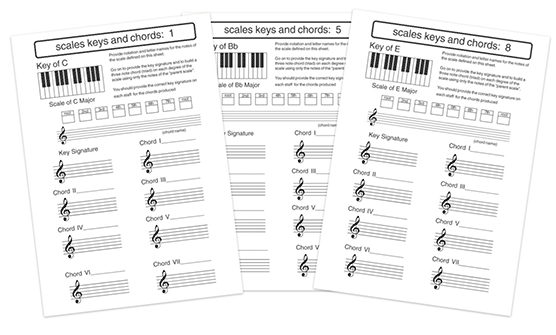
Scales Keys and Chords (triads): 10 Sheets
Worksheets requiring students to identify the letter names of the notes of a specified Major Scale. They are then tasked with writing out the scale on a staff (using accidentals). From there they go on to use the accidentals to determine the key signature. Finally they have the opportunity to notate the seven diatonic triads that can be formed from the notes of the scale. This series of worksheets can also be used with 7th chords

More Triad Worksheets: 14 Sheets
Students are required to notate specified Major Scales before taking the root, third and fifth notes of the scale to notate the major chord that is based on the first (root) note of it
The Diatonic Chord System: 10 Sheets
Learners are invited to notate a given Major Scale and then to notate and name the chords that can be constructed from it
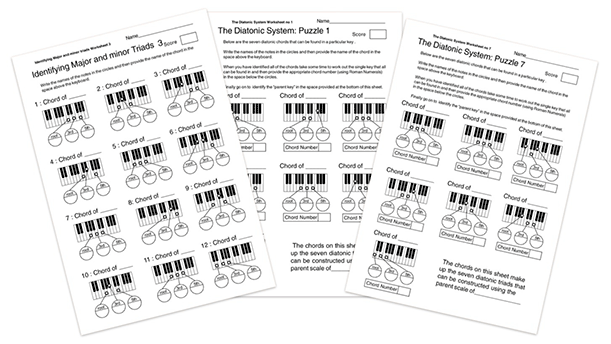
Triads and Diatonic Puzzles: 13 Sheets
7 Piano keyboard chord diagrams. Students are required to identify the chords and then to specify the key to which all of them belong. These worksheets are a great way to make students familiar with (as opposed to merely "aware of") the diatonic system

Answer Sheets for Triads and Diatonic Puzzles
Each of the "letter name only" triad worksheets and diatonic puzzles has an answer sheet designed to help you make your teaching more flexible. They can be emailed to individual students or incorporated into distance learning packs or uploaded onto school/college portals for home study
Diatonic Notation Worksheets: 11 Sheets
More worksheets designed to help students familiarise themselves with the chords to be found in particular keys

Chord Inversions and Triads: 6 Sheets
Students are presented with a series of keyboard diagrams featuring chords in root position, first inversion or second inversion. they are asked to identify the chord and any inversion that applies to it. This material can be very useful for students who may not be keyboards players but who create music on Digital Audio Workstations

Scales Keys and 7th Chords: 10 Sheets
Diatonic 7th chord worksheets giving learners the opportunity to notate chords in a range of keys
Diatonic 7th Chords Worksheets: 10 Sheets
7th chord worksheets that feature a keyboard graphic but which do not require the student to notate music. They are asked to identify the letter names of a range of 7th chords

7th Chord Worksheets: 30 Sheets
A whole range of worksheets (some requiring students to notate and some not)themed around developing and reinforcing a sound knowledge of more "complicated" chords
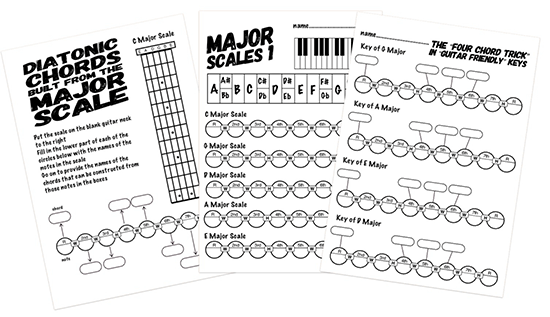
Guitar Materials

Early Stages Big Guitar Grids: 22 Sheets
The download features 22 giant (letter sized) guitar chord diagrams that can be use during guitar lessons or which can be (laminated?) and put up on the wall of your music classroom. The giant diagrams feature the most useful (and easy to play) chord shapes that any beginner should learn first
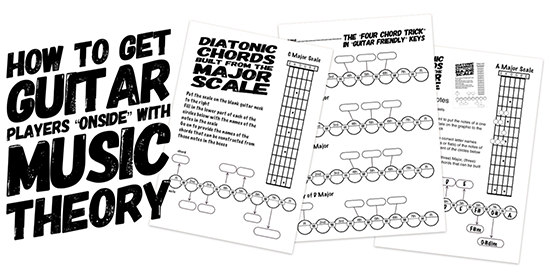
More Guitar Stuff
Follow the link below to look at our recently updated materials designed to help you to get those often "difficult to reach" guitar playing students onside with music theory
There is a whole load of useful material here looking at how chord progressions are constructed and understood from a theoretical point of view. Material such as this is a great way to get (sometimes difficult to reach) guitar players to develop an interest in music theory

Popular Song Form
A look at our materials (and a whole load of youtube videos you can use as examples) themed around the three main popular music song forms (AAA AABA and AB)
The First 12 Music Theory Lessons With Worksheets and Answer Sheets Presented In Sequence
Further down the page you will be able to see EVERYTHING in the download but first a look at the 12 "Ready-Made" Distance Learning Packs (the answer sheets are in the download too) that have been put together in order to help make our teaching flexible and responsive in today's ever-changing world
The materials basically "mirror" a series of 12 music theory lessons designed to take a student from a situation in which they have no functional understanding of music theory at all to place where they "get" Note names, intervals, scales, chords and keys.....
.... with no knowledge of notation required!
There are 12 learning packs with PDF "explainers" and a set of (separate) answer sheets to accompany the worksheets
Download ALL of our resources to your phone, tablet and/or PC for just $18.00

Online and Distance Learning Packs (with answer sheets)
(The packs use letter names only No knowledge of notation is required from students and answer sheets for all worksheets are included in the download
Partially in response to the changing ways in which many of us have been forced to teach in recent times some, but not all of the resources have been compiled into a series of distance or online learning packs that will take students from a "standing start" to a place where they fully understand note names, intervals, scales, chords and keys
For convenience they have been compiled into twelve individual multi page PDF documents but the reality is that this is the material for 12 first classroom topics designed to help to get ALL students understanding the basic melodic and harmonic elements of music theory
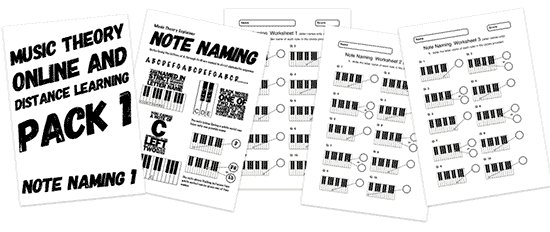
Music Theory Pack 1: Note Names 1
An "Explainer" and three worksheets to get your students naming notes correctly. When they can provide the correct letter names (or choice of letter names) for each note then they are ready to progress to the study of whole-step and half-step intervals

Pack 2: Note Names 2
The journey from "aware of" to "familiar with"
Another copy of the relevant "explainer" and two further note naming worksheets to reinforce learning before moving on to a study of whole and half-step intervals that is vital to their ability to understand how scales are constructed.
When engaged in the study of anything (not just music theory) it is important that students are not constantly bombarded with brand new information. They need time and experiences which allow them to become "familiar with" concepts that they have recently been made "aware of"
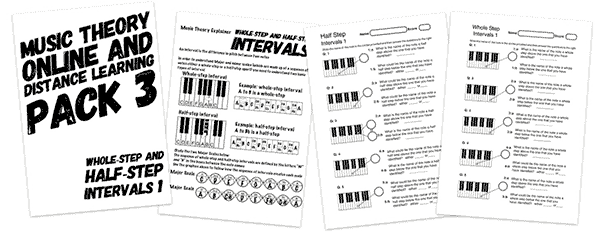
Pack 3: Whole and Half-Step Intervals 1
An "explainer" and two worksheets looking at whole-step and half step intervals that students will need to understand before they can reliably construct scales
To help you to find out if the resources could work for you...
You can Download this Music Theory Distance Learning Pack (and the answer sheets) Now!......
...by simply clicking the buttons below
You can download the answer sheets too....

Pack 4: Whole and Half-Step Intervals 2
Another copy of the music theory explainer and two more worksheets to support knowledge of these important intervals
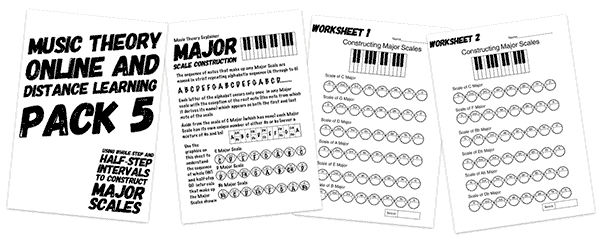
Pack 5: Major Scale construction 1
A Major Scale "Explainer" accompanied by two worksheets requiring students to correctly identify the names of the notes in a selection of Major Scales
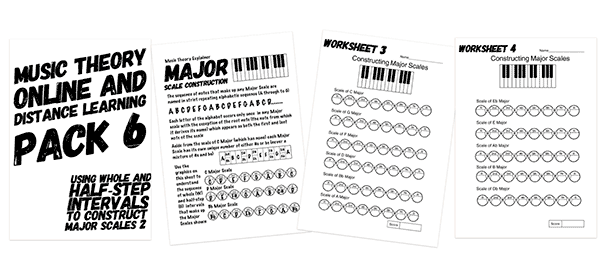
Pack 6: Major Scale Construction 2
The explainer and two supplementary worksheets designed to ensure that learners can construct any Major Scale

Pack 7: Minor Scale Construction
The minor scales "Explainer" and a pair of worksheets concerning the (different) sequence of whole-step and half-step intervals that will allow our learners to identify the notes in a range of given minor scales

Pack 8: Major and Minor Chords 1
Two Music Theory "Explainers" (one for Major and one for minor chord construction) and plus worksheet concerned with the difference between Major and minor chords

Pack 9: Major and Minor Chords 2
The Explainers again and two further worksheets designed to entrench knowledge of Major and minor triads
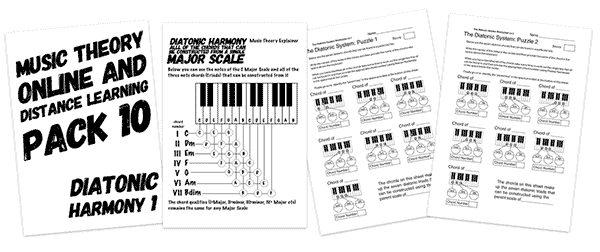
Pack 10: Chords and Keys (Diatonic harmony) 1
An "Explainer" and two worksheets related to it that look at all of the chords (built from the same Major Scale) that can be found in a particular key

Pack 11: Chords and Keys 2
The explainer again and three more worksheets looking at how the chords within a key work

Pack 12: Chords and Keys 3
The final pack featuring four more worksheets looking at the diatonic system
What else is in the download?
$18.00
How to access your simple "one click" download
You can buy your music teaching resources in complete safety via any major credit card (through paypal) or directly through your paypal account if you have one. If you choose to use a credit card, rest assured that we never see your credit card details as paypal do all of that for us.
When Paypal receive your payment you will be immediately invited to click a
"RETURN TO MERCHANT"button.
You will be taken to a page from where you can download the resources that you have paid for NOW!
In the (rare) event that something should go wrong with the order/download process just email me at robh@teachwombat.com
I will check the order and send you the links that will get you to your stuff.
Cheers! Rob!




